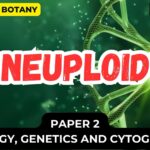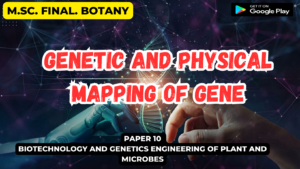Polyploidy
- In polyploidy cells and organisms the number of chromosome sets exceeds that of the diploid.
- Depending on the number of chromosome sets, polyploidy can be classified as triploids, tetrapoloids, pentaploids, etc. diploid organisms possess polyploidy cells and tissue.
- Diploid human cells have 46 chromosomes each, but in cancer cells this number may reach 100 or more due to abnormal divisions.
- In the liver of mice about 40 percent of the cells are tetraploid and about five percent are octaploid.
- Polyploidy nuclei, cells and tissue are very common even in plants.
- Endosperm nuclei are generally triploid because of triple fusion.
- Sometimes they may be tetra-, penta-, hexa-, or polyploids of even higher order.
Origin and Induction of Polyploidy
- Failure of normal mitotic divisions results into nuclei with increased sets of chromosomes.
- During mitosis in a diploid somatic cell, if the chromosomes duplicate and divide but cytokinesis fails to occur, a tetraploid cell arises.
- Normal mitotic division of this cell gives rise to a tetraploid tissue.
- Organs or branches that develop from such a tissue are tetraploid and flower borne on such branches produce diploid instead of haploid gametes.
- A doubling of the number of somatic chromosomes in a sex organ results into a doubling of the number of gametic chromosomes.
- A fusion of two diploid gametes produces a tetraploid individual.
- A fusion of a diploid and a haploid gamete results into a triploid individual.
- Even abnormal meiosis may result into a diploid gamete instead of a haploid in a diploid organism.
- Polyploidy can also occur if an egg is fertilized by more than one male gamete.
- Polyploidy can be induced with the help of chemicals, by giving temperature shocks or by causing mechanical injuries to tissues.
- In tomato plants disorganized cell division occurs at cut ends of stem and a callus tissue develops.
- Most of the cells in such a tissue are tetraploid rather than diploid. About seven percent of the branches developed from such a tissue are polyploid.
- Similarly, octaploid branches can be developed on tetraploid tissues. In plants, like maize, polyploidy can be induced by temperature shocks which disorganize cytokinesis.
- Tissues developed from a polyploid cell are polyploid. In maize short pulses of high temperature are necessary for inducing polyploidy.
- In other organisms short pulses of low temperatures or alternating high and low temperatures are required for this purpose.
- Divided nuclei can be prevented from separating in Spirogyra by refrigeration or by treatment with ether or chloroform.
- If nuclei do not separate and cytokinesis occurs, the result is a cell with two nuclei and another cell without any nucleus.
- A cell with two nuclei divides to give rise to polyploidy cells.
- Chemicals, like indole acetic acid induce cell division in non-meristematic cells, thereby inducing polyploidy.
- If the rate of nuclear division is increased, polyploidy cells arise because cell wall synthesis, which is responsible for cytokinesis, is not able to cope with the increased division rate of the nucleus.
- When roots of leguminous plants are infected with nitrogen-fixing bacteria like Rhizobium, the level of indoleacetic acid increases in cortical cells and this causes polyploidy.
- It is a matter of dispute whether indoleacetic acid induces polyploidy or simply helps in division and multiplication of a polyploidy cell.
- Let us imagine that A, B1, B2, and C are four different haploid sets of chromosomes and that genomes B1 and B2 are related. (Fig 4.5)

Figure 4.5 Different kinds of polyploids and their derivation from one or more basic diploid species
- Chemicals like colchicines and acenapthene are believed to interfere with spindle formation and thus induce polyploidy.
- Colchicine is an alkaloid which is extracted from corms of Colchicum autumnale or Colchicum luteum of the family Liliaceae.
- The corm is used as a carminative, laxative, aphrodisiac and is useful in gout, rheumatism and disease of liver and spleen and also as an external application to lessen inflammation and pain.
- Eigsti (1937) noticed that if onion bulbs are allowed to root in a 0.05 percent aqueous solution of colchicines, some cells show polyploidy and if colchicines treatment is continued as many as 1000 chromosomes can be found in a cell.
- As colchgicine prevents the formation and organization of spindle fibre, the metaphase chromosomes of affected cells (C-metaphase or colchicines metaphase) do not move to a metaphase plate and remain scattered in the cytoplasm.
- Even cytokinesis is prevented and with duplications of chromosomes their number goes on increasing.
- Soon after Eigsti discovered the polyploidy inducing potentiality of colchicines, Blakeslee, Avery and Nebel (1937) used it for getting a polyploidy plant
- Now-a-days colchicine is one of the most widely used chemicals for induction of polyploidy and for causing related effects.
- As colchicine interferes with spindle formation, its effects are limited to dividing or meristematic cells.
- Once a polyploidy cell is formed, its normal division gives rise to a polyploidy tissue, branch, flowers, fruits, seeds, etc., and a polyploidy variety is established.
Polyploidy
There are mainly three different kinds of polyploids, namely
- Autopolyploid,
- Allopolyploids, and
- Auto allopolyploids.

Fig. 4.6. Interrelationships of auto- and allopolyploids. (After Stebbins, 1950).
Autopolyploids
- Autopolyploids are those polyploids, which has the same basic set of chromosomes multiplied.
- For instance, if a diploid species has two similar sets of chromosomes or genomes (AA), an autotriploid will have three similar genomes (AAA) and an autotetraploid will have four such genomes (AAAA) as shown in figure.
Origin and production of autopolyploids.
- The autopolyploids may occur in nature or may be artificially produced.
- When they are found in nature, their autopolyploid nature is inferred mainly by their meiotic behaviour.
- One of the very common examples of natural autopolyploidy relevant to northern India pertains to common ‘doob’ grass (Cynodon dactylon). In U.P. and Bihar, common ‘doob’ grass was found to be an autotriploid as inferred from its meiotic behaviour (Gupta and Srivastava, 1970).
- It is perhaps successful due to efficient vegetative reproduction, because, as will be seen, autopolyploids are normally triploids and set no seeds.
- Autotriploids are also known in watermelons, sugarbeet, tomato, grapes and banana; although in several of these cases the polyploids have been artificially produced.
- Similarly autopolyploids are known in rye (Secale cereale), corn (Zea mays), red clover (trifolium prantese), berseem (trifolium alexandrium), marigolds (Tagetes), snapdragons (Antirrhinum), Phlox, grapes, apples, etc.
- In Oenothera lamarckiana, an American plant, a giant mutant described by Hugo de Vries was later discovered to be an autotetraploid.
Induced autopolyploids.
- In many cases listed above, autopolyploidy is artificially induced.
- Since polyploids are normally larger and more vigorous, their role in crop improvement has been realized and techniques developed for artificial induction of polyploidy.
- Polyploidy is mainly induced by treatment with aqueous solution of a drug called colchicine.
- This drug has the property of arresting and breaking the spindle so that a cell division without cell wall formation may be affected leading to doubling of chromosome number.
- The concentration of aqueous solution of colchicines may vary from 0.01% to 0.50% and the treatment may be given in one of the following manners.
- Seed treatment may be mainly given by soaking seeds for different durations in aqueous solution of colchicines.
- Injections of colchicines solution may also be given at seedling stage so as to inject solution into cortex tissue with the help of a hypodermic needle.
- Axillary bud treatment is also effective. Since bud is meristematically active, placing cotton soaked in colchicine on the bud and continuous dropping of solution on cotton leads to induction of polyploidy in the branch arising from the treated bud.
- Shoot apex treatment is brought about just like bud treatment and is fairly effective, but the shoot apex should come in direct contact of the solution. In order to facilitate this, young leaves covering the shoot apex may be removed.
- Colchicine is an alkaloid extracted from seed and corm of Colchicine autumnale.
- The action of colchicines and its use in inducing polyploidy was first studied in 1930’s.
- The successful doubling of chromosome number was described for the first time by Levan (1938) and by Eigsti (1938 – 40).
- It was surprising however, that colchicine does not affect colchicum, the plant from which it is extracted. This was attributed to the presence of an ‘anticolchicine’.
- The success of colchicine treatment depend on three prerequisites, namely
- direct contact of growing tissue with solution,
- effective concentration of colchicine and
- The optimal stage of development.
These three conditions are met with in the methods of treatment described above.
Effects of chromosome doubling.
- One of the important effects of polyploidy is to produce ‘gigantism’.
- The autopolyploids may be normally larger in size. Sometimes plants may be smaller than diploids.
- But leaves, flowers, and the cells themselves may be bigger in size. Some of the important effects of polyploidy are as follows:
- With increase in cell size, water content increases leading to decrease in osmotic pressure.
- This results into loss of resistance against frost, etc.
- Growth rate decreases due to slower rate of cell division; this leads to a decrease in auxin supply and a decrease in respiration.
- In autopolyploids, time of blooming is delayed and prolonged due to slow growth rate.
- At higher ploidy level (autooctoploids or higher), the adverse effects are highly pronounced and lead to death of plants.
Cytology of autopolyploid.
- In an autopolyploid, there will be more than two sets of homologous chromosomes.
- This leads to formation of multivalents instead of bivalent as found in diploids.
- An important difference exists even between autotriploids and autotetraploids, because while in the latter normal disjunction is possible giving rise to diploid gametes, in triploids it is not possible.
- In an autotriploid, there are three sets of homologous chromosomes.
- If these three sets are normally paired, trivalents can not disjoin normally and will either disjoin 2:1 chromosomes to two poles or will disjoin 1:1 leaving one chromosome as a laggard.
- The number of chromosomes in gametes of triploid organism, therefore, will vary from n to 2n. Most of these gametes are unbalanced leading to high degree of sterility.
- In autotetraploids, since there are four sets of chromosomes, quadrivalents are formed, which disjoin in a normal 2:2 manner giving diploid gametes.
- Rarely however, a quadrivalent may disjoin 3:1 or may leave a chromosome as a laggard at anaphase I.
- Therefore autotetraploids also have a certain degree of sterility, although it will not be as high as on autotriploids.
Allopolyploids.
- Polyploidy may also result from doubling of chromosome number in a F1 hybrid which is derived from two distinctly different species.
- This will bring two different sets of chromosomes in F1 hybrid.
- The number of chromosomes in each of these two sets may differ.
- Let A represent a set of chromosomes (genome) in species X, and let B represent another genome in a species Y.
- The F1 will then have one A genome and another B genome.
- The doubling of chromosomes in this F1 hybrid (AB) will give rise to a tetraploid with two A and two B genomes.
- Such a polyploidy is called an allopolyploid or amphidiploid.
- Raphanobrassica is a classical example of allopolyploidy.
- In 1927, G. D. Karpechenko, a Russian geneticist, reported a cross between Raphanus sativus (2n = 18) and Brassica oleracea (2n = 8) to produce F1 hybrid which was completely sterile.
- This sterility was due to lack of chromosome pairing, since there is no homology between genomes from Raphanus sativus and Brassica oleracea.
- Among these sterile F1 hybrids, Karpechenko found certain fertile plants.
- On cytological examination these fertile plants were found to have 2n = 36 chromosomes, which showed normal pairing into 18 bivalents.

Evolution of Wheat.
- Common cultivated wheat is another important example of allopolyploidy, although its allopolyploid nature has now been questioned.
- There are three different chromosomes numbers in the genus Triticum, namely 2n = 14, 2n = 28, 2n = 42.
- The common wheat is hexaploid with 2n = 42 and is derived from three diploid speices:
- (i) AA = Triticum aegilopoides (2n = 14),
- (ii) BB = Aegilops speltoides ? (2n = 14)(in the past evidence was made available, showing that Ae. Speltoides may not be the donor of E genome; it is also believed that the donor of E genome may never be discovered) and
- (iii) DD = Aegilops tauschii, earlier known as Ae.squarrosa (2n = 14). The hexaploid wheat, therefore, is designated as AABBDD, the tetraploid (2n = 28) as AABB and diploid (2n = 14) as AA.
- There is, however, evidence available now which suggests that A, B and D genomes from three diploid species mentioned above are not much different from one another, so that it is believed that the three diploid progenitors of common hexaploid wheat were derived from a common ancestor.
- For this reason, the common hexaploid wheat is now considered an autopolyploid rather than an allopolyploid.
- At best, it may be a segmental allopolyploid. (Fig.4.8)
- Triticale (x Triticosecale), a new man made cereal.
- During the last decades, considerable emphasis has been laid on the possibility of utilizing a new man made cereal known as triticale, on a commercial scale.
- It is already grown in an estimated area of more than three million hectares and research at several places all over the world is in progress to improve this man made crop.
- Triticale is the first man made crop, in so far as it resulted as an artificial allopolyploid derived by crossing wheat (Triticum) and rye (Secale).
- Depending upon whether tetraploid (2n = 4x = 28) or hexaploid (2n = 6x = 42) wheat is utilized for the synthesis, one would get hexaploid triticale (2n = 6x = 42) or octoploid triticale (2n = 8x = 56) respectively. In each case, only diploid rye (2n = 2x = 14) was used.


Fig.4.8 Diagrammatic representation of the origin of tetraplooid and hexaploid cultivated wheat from their wild ancestors






